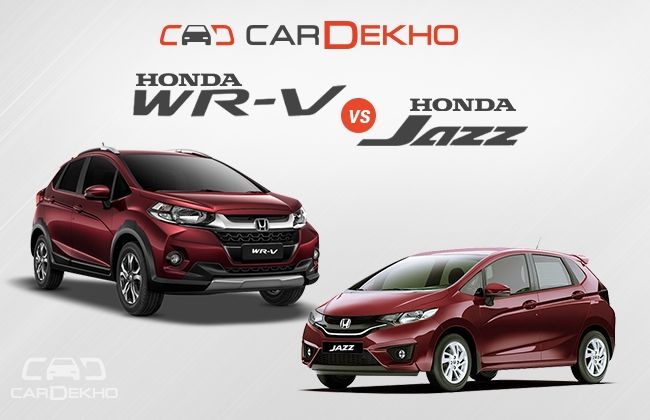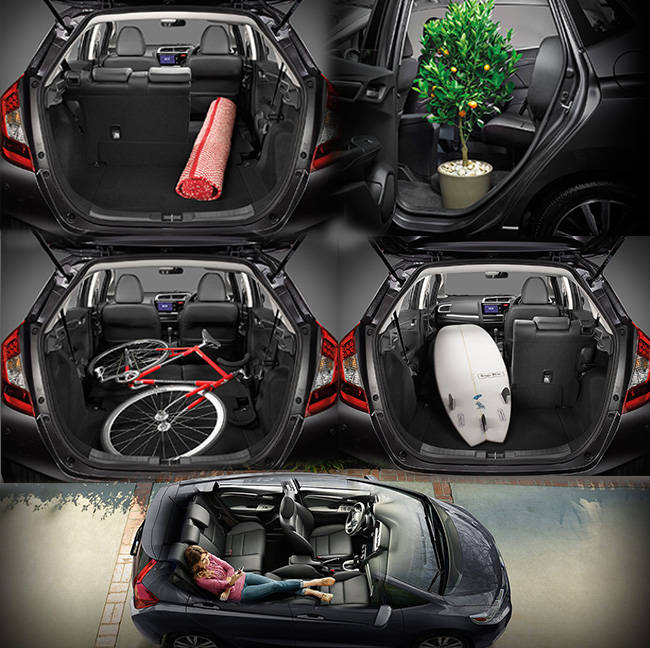Honda WR-V Vs Jazz: What’s Different

The Honda WR-V gets several features that are missing in the Jazz, but the famed Magic Seats are still exclusive to the latter

Honda entered the sub-4m SUV segment in India in 2017 with the WRV. The WR-V shares its underpinnings with the Honda Jazz and there’s a lot common between the two cars. Since the WR-V is the costlier of the two, let’s have a look at what it has to offer over the Jazz. 
Aesthetics

- It is a result of the same formula that Honda tried with the BRV. It shares most of its body panels with the Jazz, just like the BR-V shares with the Mobilio
- The front profile features a high-set bonnet unlike the Honda Jazz and comes with LED daytime running lights, which are not present in the hatch
- The side profile is nearly identical, but it gets all-around body cladding and gets 16-inch wheels with 195/60 cross-section tyres as standard, unlike the equivalent Jazz’ 15-inch wheels with 175/65 cross-section tyres
- The rear profile gets subtle differences such as the lower placement of the license plate and cleverly designed split tail lamps (half of which is similar to the Jazz)

- New exclusive exterior shade: Premium Amber

- The dashboard is similar to the range-topping Jazz VX, featuring an all-black cabin, but the WRV, like the Hyundai i20 Activ, gets two colour theme options: Urban Casual (black and bluish grey upholstery) and Urban Sophisticated (black and silver upholstery)

Limited Variant Options
- Unlike the Jazz, which is available in five trim levels (E, S, SV, V and VX), the WR-V will come in two variant options: S and VX
No Automatic Option
- Unlike the Jazz, the petrol WR-V doesn’t get CVT with paddle shifters. It comes with a 5-speed manual transmission with the petrol engine and a 6-speed manual transmission with the diesel
Lowered Fuel Efficiency
- Even though both the cars share their mechanicals, the certified fuel efficiency figures of the WR-V are slightly lower than the Jazz because the former is slightly heavier than the latter. The petrol WR-V returns 17.5kmpl (1.2kmpl less), while the diesel returns 25.5kmpl (1.8kmpl less)
| Honda Jazz | Honda WR-V | |
| Kerb Weight | 1044kg (P)/ 1154kg (D) | 1104kg (P) (+60kg)/ 1204kg (D) (+50kg) |
No Magic Seats
- Though the WR-V’s entire cabin is a carbon copy of the Jazz, it misses out on the Magic Seats which are the USP of the hatch. These flexible seats offer several adjustment levels that come in handy while carrying luggage. And since there are no Magic Seats, the WR-V doesn’t get the rear seat recline function of the Jazz as well. However, the WR-V does offer a slightly larger boot space of 363 litres compared to the Jazz’s 354 litres

(In Picture: Magic Seats of the Honda Jazz)
Increased Dimensions and Ground Clearance
- Though the WRV is based on the Jazz platform, which is also shared with the City and the HR-V (not offered in India yet), it has slightly larger dimensions and rides higher off the ground as well. The WRV is 44mm longer, 40mm wider and 57mm taller, and features a 23mm longer wheelbase. The cabin space is nearly similar to that on the Jazz, which is not a bad thing. In the WR-V’s case, the axles are shifted to the extremities to improve its soft-roading capabilities
Check out: Spec Comparo - Honda WR-V Vs Maruti Vitara Brezza Vs Ford EcoSport
Extra Features

- The range-topping WR-V gets a sunroof with one-touch open and close function, making it the most economical offering the country to get a standard sunroof in its top-end model. The Jazz doesn’t offer a sunroof, not even as an option
- Honda’s new 7-inch infotainment – Digipad, which made its debut recently with the facelift City – is on offer in the WR-V as well. Check out the features of the new unit here: Honda WR-V To Feature 2017 City's 7.0-Inch Infotainment Unit. The Jazz, on the other hand, comes with an old-school resistive touch-based 6.2-inch touchscreen infotainment system

- Unlike the Jazz’s four-speaker system, the infotainment system in the WRV is paired to a six-speaker system
- The WRV’s steering can also be adjusted for reach, which is not the case with the Jazz
- The WR-V features a central armrest, which is an optional fitment in the Jazz. The armrest in the WRV gets a 12V socket and USB-in port integrated into it in addition to the ones below the AC panel
- In terms of safety, the WRV comes with dual front airbags and ABS with EBD as standard. The Jazz also offers dual front airbags as standard. While ABS with EBD is standard in the diesel Jazz, the petrol model features these from the SV onward
- The WRV also offers passive keyless entry with engine push-button start-stop, which is sorely missing in the Jazz. However, this feature is only offered with the range-topping diesel model of the WRV

Price (ex-showroom New Delhi)
| Honda WR-V petrol | Honda Jazz petrol |
| E MT Rs 5.89 lakh | |
| S MT - Rs 7.66 lakh | S MT Rs 6.52 lakh |
| SV MT Rs 6.96 lakh | |
| V MT Rs 7.31 lakh | |
| VX MT - Rs 8.88 lakh | VX MT Rs 7.80 lakh |
| Honda WR-V diesel | Honda Jazz diesel |
| E MT Rs 7.23 lakh | |
| S MT - Rs 8.71 | S MT Rs 7.91 lakh |
| SV MT Rs 8.31 lakh | |
| V MT Rs 8.77 lakh | |
| VX MT - Rs 9.91 lakh | VX MT Rs 9.19 lakh |
While the Honda WR-V is based on the Jazz and shares a lot with its hatchback sibling, it has its own unique identity. The WR-V is more feature rich and stands out better in a sea of cars compared to the Jazz, which is a quintessentially no-nonsense practical hatchback. Which one would you pick? Let us know in the comments section below.
Recommended Reads
Read More on : WRV price
This Story has not been edited by ABP News. It has been published through cardekho.com feed directly.






































